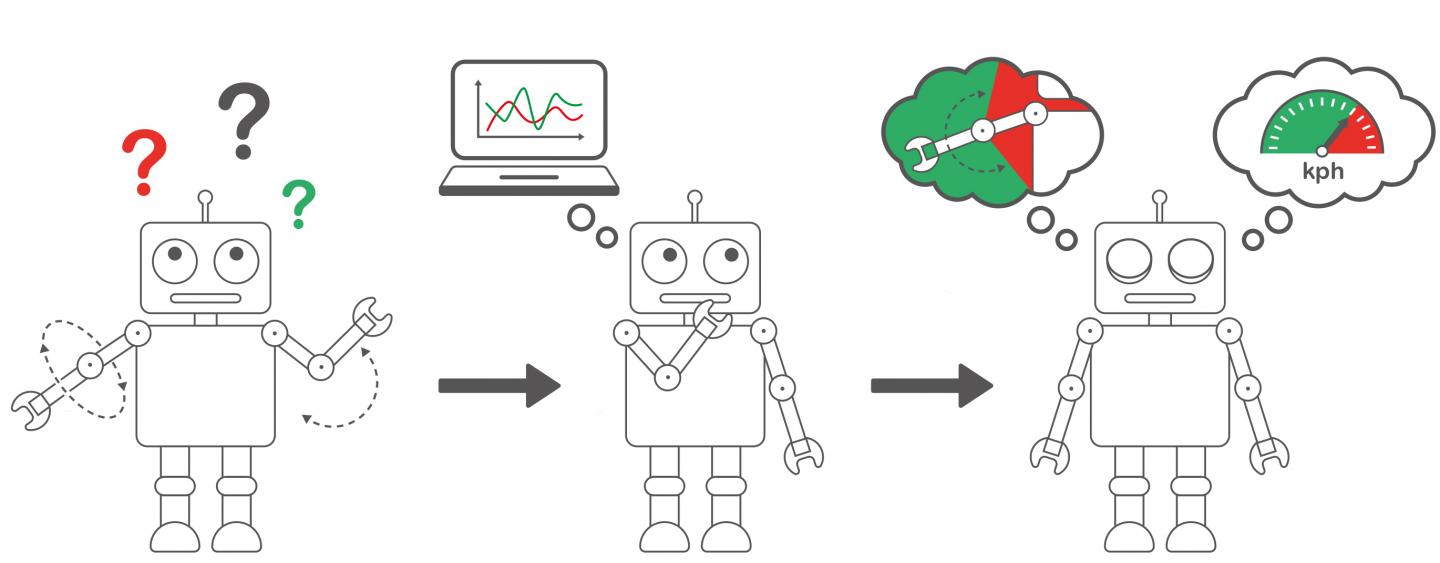
A robot needs to learn about his body and the environment. It tries a few different motions and uses the algorithm. It can then predict what will happen with larger movements and at higher speeds. Credit: IST Austria/Birgit Rieger
Understanding how a robot will react under different conditions is essential to guaranteeing its safe operation. But how do you know what will break a robot without actually damaging it? A new method developed by scientists at the Institute of Science and Technology Austria (IST Austria) and the Max Planck Institute for Intelligent Systems (MPI for Intelligent Systems) is the first machine learning method that can use observations made under safe conditions to make accurate predictions for all possible conditions governed by the same physical dynamics. Especially designed for real-life situations, their method provides simple, interpretable descriptions of the underlying physics. The researchers will present their findings tomorrow at this year’s prestigious International Conference for Machine Learning (ICML).
In the past, machine learning was only capable of interpolating data–making predictions about situations that are “between” other, known situations. It was incapable of extrapolating–making predictions about situations outside of the known–because it learns to fit the known data as closely as possible locally, regardless of how it performs outside of these situations. In addition, collecting sufficient data for effective interpolation is both time- and resource-intensive, and requires data from extreme or dangerous situations. But now, Georg Martius, former ISTFELLOW and IST Austria postdoc, and since 2017 a group leader at MPI for Intelligent Systems in Tübingen, Subham S. Sahoo, a PhD student also at MPI for Intelligent Systems, and Christoph Lampert, professor at IST Austria, developed a new machine learning method that addresses these problems, and is the first machine learning method to accurately extrapolate to unseen situations.
The key feature of the new method is that it strives to reveal the true dynamics of the situation: it takes in data and returns the equations that describe the underlying physics. “If you know those equations,” says Georg Martius, “then you can say what will happen in all situations, even if you haven’t seen them.” In other words, this is what allows the method to extrapolate reliably, making it unique among machine learning methods.
The team’s method sets itself apart in several other ways as well. First, the final approximations previously produced during machine learning were far too complex for a human to understand or work with. In the new method, the resulting equations are far simpler: “Our method’s equations are something you would see in a textbook–simple and intuitive,” says Christoph Lampert. The latter is another key difference: other machine learning methods give no insight into the relationship between conditions and results–and thus, no intuition on whether the model is even plausible. “In every other area of research, we expect models that make physical sense, that tell us why,” adds Lampert. “This is what we should expect from machine learning, and what our method provides.” Finally, in order to guarantee interpretability and optimize for physical situations, the team based their learning method on a different type of framework. This new design is simpler than previous methods, which in practice means that less data is needed to give the same or even better results.
And it’s not all theory: “In my group, we’re actually working on developing a robot that uses this type of learning. In the future, the robot would experiment with different motions, then be able to use machine learning to uncover the equations that govern its body and movement, allowing it to avoid dangerous actions or situations,” adds Martius. While robots are one active area of research, the method can be used with any type of data, from biological systems to X-ray transition energies, and can also be incorporated into larger machine learning networks.




